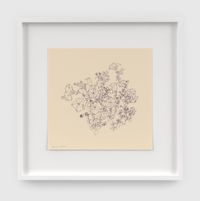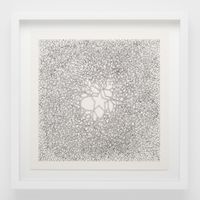An influential sculptor, devoted activist, and tireless advocate for arts education, Ruth Asawa (1926-2013) is best known for her extensive body of hanging wire sculptures. Intricate, dynamic, and sinuous, these remarkable works, begun in the late 1940s, continue to challenge conventional notions of sculpture through their emphasis on lightness and transparency. Explaining her fascination with wire as a material, Asawa said, “I was interested in it because of the economy of a line, making something in space, enclosing it without blocking it out. It’s still transparent. I realized that if I was going to make these forms, which interlock and interweave, it can only be done with a line because a line can go anywhere.”¹
Read MoreSince early 2017, the Estate of Ruth Asawa has been represented by David Zwirner. The gallery's first solo exhibition of the artist's work is currently on view at the 537 West 20th Street location in New York (through October 21, 2017). An accompanying monographic catalogue will be published by David Zwirner Books and include new scholarship on Asawa's groundbreaking body of work by art historian Tiffany Bell, as well as an essay by Robert Storr, and an illustrated chronology. The artist's work will be concurrently on view in Josef and Anni and Ruth and Ray, the inaugural exhibition at David Zwirner's new Upper East Side location at 34 East 69th Street.
Born in Norwalk, California to Japanese immigrants, Asawa enrolled Milwaukee State Teachers College in 1943, but was unable to receive her degree due to continued hostility against Japanese Americans. In 1946, Asawa began to study at Black Mountain College in North Carolina, renowned at the time for its progressive pedagogical methods and avant-garde aesthetic milieu. Here, Asawa absorbed the vital teachings and influences of Josef Albers, Buckminster Fuller, and Merce Cunningham, among others, and embraced her own vocation as an artist.
Asawa has exhibited widely throughout the world since the early 1950s, including solo exhibitions at Peridot Gallery, New York in 1954, 1956, and 1958. In 1965, Walter Hopps organized a solo exhibition of the artist’s sculptures and drawings at the Pasadena Art Museum (now Norton Simon Museum) in California, where the artist completed a residency at the Tamarind Lithography Workshop the same year. Other solo presentations include those held at the San Francisco Museum of Art, 1973; Fresno Art Museum, California, traveled to Oakland Museum of California; 2001-2002; de Young Museum, San Francisco, 2006; Amon Carter Museum of American Art, Fort Worth, Texas, 2012; and Norton Simon Museum of Art, California, 2014.
Work by the artist has been included in a number of major group exhibitions, including the Annual Exhibition at the Whitney Museum of American Art, New York, 1955 and 1958; the São Paulo Biennial, 1955; and The Museum of Modern Art, New York, 1959, among others. Most recently, her work was featured in the critically acclaimed traveling 2015-2017 group exhibition Leap Before You Look: Black Mountain College 1933-1957, held at the Institute of Contemporary Art, Boston; Hammer Museum, Los Angeles; and Wexner Center for the Arts in Columbus, Ohio. In 2015, her work was on view as part of America is Hard to See, the inaugural exhibition at the Whitney Museum of American Art’s new building in New York. Other recent group exhibitions include Revolution in the Making: Abstract Sculpture by Women, 1947-2016, Hauser & Wirth, Los Angeles, 2016; Making Space: Women Artists and Postwar Abstraction, The Museum of Modern Art, New York; and Where We Are: Selections from the Whitney’s Collection, 1900-1960, Whitney Museum of American Art, New York, both 2017.
In addition to her wire sculptures, Asawa is well known for her public commissions, particularly in San Francisco and the wider Bay Area. These include the much beloved fountains in Ghirardelli Square, 1968, and outside the Grand Hyatt San Francisco, 1973, the latter of which comprises hundreds of Baker clay images molded by local schoolchildren, friends, and other artists cast in bronze. Upon moving to San Francisco in 1949, Asawa, a firm believer in the radical potential of arts education from her time at Black Mountain College, devoted herself to expanding access to art-focused educational programs. She co-founded the Alvarado Arts Workshop in 1968 and was instrumental in the opening of the first public arts high school in San Francisco in 1982, which was renamed the Ruth Asawa San Francisco School of the Arts in her honor in 2010. Asawa believed that “Art will make people better, more highly skilled in thinking and improving whatever business one goes into, or whatever occupation. It makes a person broader.”2
The artist’s work is represented in prominent museum collections, including Crystal Bridges Museum of American Art, Bentonville, Arkansas; M.H. de Young Memorial Museum, San Francisco; Harvard Art Museums, Cambridge, Massachusetts; The Museum of Modern Art, New York; San Francisco Museum of Modern Art; San Jose Museum of Art, California; Whitney Museum of American Art, New York, among others. Asawa has been the recipient of numerous prestigious awards.
¹ Ruth Asawa quoted in Douglas Martin, “Ruth Asawa, an Artist Who Wove Wire, Dies at 87,” The New York Times (August 17, 2013).
2 Ibid.
Text courtesy David Zwirner.



![Untitled (P.002-I Tied-Wire Sculpture Drawing with Five-Pointed Center Star, Embossed [Silver]) by Ruth Asawa contemporary artwork works on paper, mixed media](https://files.ocula.com/anzax/29/29b0c3ad-9578-4ea3-88ff-e1555af2202a_200_201.jpg)
